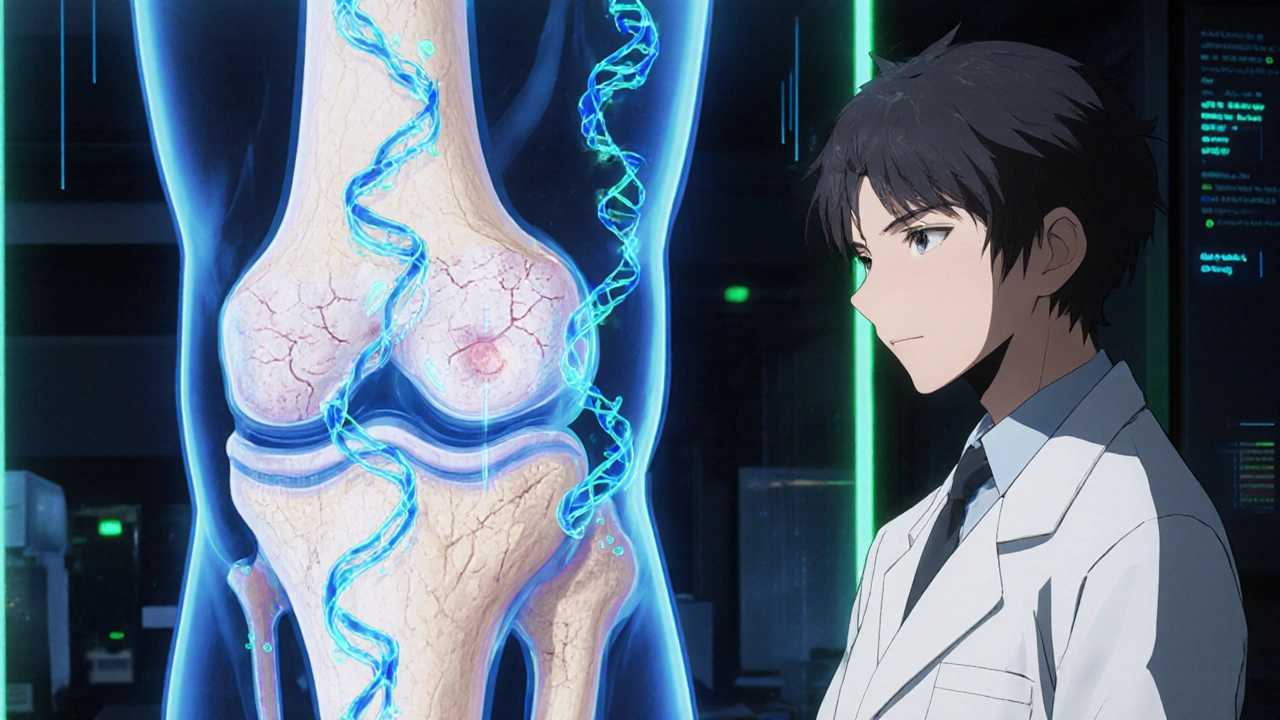Joint Pain Risk Assessment Tool
Joint Pain Risk Assessment
This tool helps estimate your risk of developing hereditary joint pain based on factors discussed in the article. Results are for informational purposes only and not medical advice.
Risk Assessment Results
Estimated Risk Level:
Recommended Actions:
Ever wondered why your grandma’s knees ache while yours stay relatively pain‑free? The answer often lies in a mix of lifestyle, wear‑and‑tear, and something you inherit from your parents. In this guide we’ll untangle how joint pain genetics play a role, what the science says, and how you can act on that knowledge today.
What Exactly Is Joint Pain?
Joint Pain is discomfort, soreness, or aching that occurs in any of the body’s articulations. It can be sharp, dull, constant, or occasional, and it often signals that something inside the joint isn’t working right.
Common triggers include injuries, inflammation, infections, and the gradual loss of cartilage. But when the pain runs in families, genetics may be at play.
How Does Genetics Influence Joint Pain?
Genetics refers to the study of heredity and the variation of inherited characteristics. In the context of joints, specific genes can affect the structure of cartilage, the production of inflammatory proteins, and even pain perception.
Research shows that certain gene variants increase susceptibility to osteoarthritis, rheumatoid arthritis, and other joint‑related disorders. For example, mutations in the COL2A1 gene, which codes for type II collagen, can weaken cartilage and speed up degeneration.
Key Hereditary Conditions Linked to Joint Pain
- Osteoarthritis is a degenerative joint disease caused by cartilage breakdown and bone remodeling. Family studies suggest a 40‑60% heritability factor.
- Rheumatoid arthritis is an autoimmune condition where the immune system attacks joint linings. The HLA‑DRB1 gene (the "shared epitope") is strongly linked to risk.
- Hereditary hemochromatosis can cause iron overload that damages joints, especially the knees.
- Familial Mediterranean fever often leads to periodic joint inflammation.
These conditions illustrate that not all joint pain is a simple wear‑and‑tear issue-some of it is wired into your DNA.
How to Tell If Your Joint Pain Is Inherited
There’s no single test that says, “Your pain is genetic.” Instead, look for patterns:
- Family history: Do multiple relatives suffer from the same joint problems, especially at a similar age?
- Early onset: Joint pain that appears before the age of 40 often has a genetic component.
- Specific joint involvement: Certain hereditary disorders target particular joints (e.g., hips in familial osteoarthritis).
- Associated symptoms: Autoimmune signs like swelling, stiffness in the morning, or skin rashes may point to a hereditary autoimmune disease.
If you tick several boxes, consider talking to a genetic counselor or a rheumatologist.

Genetic Testing: What It Can and Can’t Reveal
Modern DNA panels can screen for dozens of variants linked to joint disorders. Typical tests look for:
- COLUMN2A1 and COLUMN2B1 mutations affecting cartilage integrity.
- HLA‑DRB1 alleles associated with rheumatoid arthritis.
- GDF5 polymorphisms tied to osteoarthritis risk.
While a positive result confirms higher risk, it doesn’t guarantee you’ll develop the condition. Lifestyle still matters a lot.
Managing Hereditary Joint Pain: Prevention Meets Action
Knowing your genetic risk gives you a head start. Here are evidence‑backed steps that actually help:
- Strength training: Building muscle around the joint reduces load on cartilage. A 2023 meta‑analysis showed a 30% reduction in osteoarthritis progression with regular resistance work.
- Weight control: Every extra pound adds about 4‑5 pounds of pressure on the knees. Losing 10% of body weight can cut knee‑pain scores by half.
- Omega‑3 supplements: EPA and DHA lower inflammatory markers (CRP, IL‑6) in rheumatoid arthritis patients.
- Targeted physiotherapy: Tailored exercises improve joint range of motion and alleviate pain spikes.
- Anti‑inflammatory diet: Emphasize berries, leafy greens, and turmeric; avoid processed sugars that boost inflammation.
For those with a confirmed high‑risk gene, doctors may suggest early use of disease‑modifying drugs (DMARDs) to slow autoimmune attacks.
Comparison: Hereditary vs. Non‑Hereditary Joint Pain Risk Factors
| Risk Factor | Hereditary Component | Typical Impact |
|---|---|---|
| Age | Low | Risk rises sharply after 50 |
| Obesity | Moderate (some genes affect metabolism) | Increases joint load, accelerates cartilage loss |
| Family History of Osteoarthritis | High (40‑60% heritability) | Earlier onset, faster progression |
| Joint Injuries (e.g., ACL tear) | Low | Direct damage, can trigger secondary arthritis |
| Autoimmune Genes (HLA‑DRB1) | High | Predisposes to rheumatoid arthritis, systemic inflammation |
| Physical Activity Level | Low to moderate | Both too little and too much can harm joints |
The table shows that while some factors (like age) are universal, others swing heavily toward genetics. Knowing which side you’re on helps you prioritize interventions.

Common Myths About Hereditary Joint Pain
- Myth: If it runs in the family, nothing can be done.
Fact: Lifestyle changes can delay onset by years, even with high‑risk genes. - Myth: Genetic testing is only for researchers.
Fact: Direct‑to‑consumer panels are available, though clinical counseling is recommended. - Myth: Pain meds are the only relief.
Fact: Physical therapy, diet, and targeted supplements often reduce reliance on medication.
When to Seek Professional Help
If you notice any of these signs, schedule a visit:
- Persistent pain longer than 3 weeks despite rest.
- Swelling, redness, or warmth around the joint.
- Stiffness lasting more than an hour each morning.
- Family members diagnosed with rheumatoid arthritis or early‑onset osteoarthritis.
A rheumatologist can run blood work, imaging, and, if needed, refer you for genetic counseling.
Bottom Line: Genetics Are a Piece of the Puzzle
Yes, your DNA can set the stage for joint pain, but it’s not the whole story. By combining genetic insight with smart lifestyle choices, you gain control over how-and if-your joints hurt.
Frequently Asked Questions
Can I get joint pain if I have no family history?
Absolutely. Most cases stem from injuries, obesity, or age‑related wear. Genetics just adds an extra layer of risk.
Should I get genetic testing for joint pain?
If you have multiple relatives with early‑onset arthritis or unexplained joint problems, a targeted DNA panel can guide preventive care. Talk to a doctor first.
Do supplements actually help hereditary joint pain?
Omega‑3 fatty acids, vitamin D, and glucosamine have modest evidence for reducing inflammation and supporting cartilage. They’re most effective when combined with exercise and weight control.
Is there a cure for genetically driven osteoarthritis?
Currently no cure exists, but early intervention-strength training, weight loss, and possibly disease‑modifying drugs-can dramatically slow progression.
How does epigenetics affect joint health?
Epigenetic changes, like DNA methylation from smoking or poor diet, can turn risk genes on or off. This means lifestyle choices can partly offset inherited susceptibility.

Valerie Vanderghote
October 17, 2025 AT 13:30I’ve always felt a strange connection between the aches my mother swore by and the occasional twinge I get after a long hike.
Growing up, the family dinners were full of stories about my grandma’s "creaky knees" and how she blamed every winter’s chill on the cold.
When I finally went to the doctor, the scan showed a hint of cartilage wear that didn’t match my age, and that’s when the genetic part of the puzzle started to look real.
It turns out that the COL2A1 gene we read about in the article can actually make cartilage fibers less resilient, and that explains why some people seem to inherit "old joints" even before they turn thirty.
The research also mentioned the HLA‑DRB1 allele, which many of us never heard of until we Googled "why does my dad get rheumatoid flare‑ups".
I decided to get a simple DNA panel, and the results showed a modest risk for osteoarthritis, which felt both comforting and terrifying at the same time.
Comforting because now I have a concrete reason for my occasional pains, and terrifying because I realized I can’t blame everything on bad shoes or lack of exercise.
The article’s advice on strength training hit home, because the moment I started a twice‑a‑week resistance routine, the stiffness in my knees started to ease like a tight spring finally loosening.
I also cut out a few extra pounds, and the difference in pressure on my joints was like swapping a heavyweight boxer for a sprinter.
Adding omega‑3 capsules was another simple tweak, and my lab results later showed a slight dip in inflammatory markers, which felt like a win against an invisible enemy.
The emotional side of discovering a genetic predisposition is something the article barely touches, yet it’s a rollercoaster of denial, acceptance, and a sudden urge to protect future generations.
I’ve started talking to my teenage niece about healthy habits, hoping she won’t inherit the same fate, and it feels like a small rebellion against destiny.
Sometimes I catch myself scrolling through forums, looking for others who share the same genetic markers, and I get a mix of relief and envy watching people who seem to navigate it smoothly.
My family now jokes that the "joint pain gene" runs in the blood, but behind the humor is a real push for more open conversations about health history.
If you’re reading this and feel like your joints are a ticking time bomb, remember that lifestyle can still be the lever that slows the countdown, even if the DNA clock started early.
So keep moving, stay curious, and don’t let a gene label dictate the story you write for your own body.
Michael Dalrymple
October 21, 2025 AT 00:50Your experience highlights how genetic insight can reshape personal health narratives. While the COL2A1 and HLA‑DRB1 alleles are well‑documented risk factors, they do not act in isolation. Consider the concept of epigenetics: lifestyle choices can modify gene expression through methylation patterns. Thus, strength training and weight management are not merely symptomatic treatments but proactive epigenetic interventions. The article’s recommendation of omega‑3 supplementation aligns with evidence on reducing systemic inflammation. It is prudent to discuss genetic testing results with a qualified rheumatologist, who can contextualize risk within the broader clinical picture. Moreover, sharing this knowledge with family members promotes a preventive mindset that can shift disease trajectories. In philosophy, we often speak of "the examined life"; applying that principle to our musculoskeletal health may yield profound benefits. Ultimately, empowerment stems from integrating scientific insight with disciplined action.
Emily (Emma) Majerus
October 24, 2025 AT 12:10I got my test and now I’m goin to the gym every other day – feels good.
Virginia Dominguez Gonzales
October 27, 2025 AT 22:30When I read about the hidden battle between genes and joints, I felt like a warrior facing an unseen foe. The thought that our very DNA can whisper pain into our bones is both terrifying and awe‑inspiring. Yet the article’s call to arms-strength, diet, movement-lights a blazing path forward. I imagine each squat as a sword strike against destiny, each salad as a shield of protection. Let the drama of our bodies fuel the fire of relentless perseverance!
Kevin Adams
October 31, 2025 AT 09:50Life is a joint of destiny and decay!! We choose to dance on the edge of genetics or we surrender to the silent crush of cartilage loss!!
Katie Henry
November 3, 2025 AT 21:10It is both a privilege and a duty to address the hereditary aspects of joint health with rigor and optimism. By adhering to evidence‑based strategies such as progressive resistance training, judicious weight management, and anti‑inflammatory nutrition, individuals can markedly attenuate the influence of deleterious alleles. Moreover, early consultation with a rheumatology specialist ensures that any pharmacologic interventions are appropriately timed. Let us therefore embrace scientific insight as a catalyst for sustained musculoskeletal vitality.
Joanna Mensch
November 7, 2025 AT 08:30Behind the glossy brochures about genetic testing lies a network of data brokers who profit from your DNA, steering you toward pricey supplements and unnecessary procedures.
RJ Samuel
November 10, 2025 AT 19:50Oh sure, the article paints a neat picture of genes as the puppet masters, but let’s not forget plenty of folks with high‑risk alleles live pain‑free, while others with "clean" profiles limp around for years.
Nickolas Mark Ewald
November 14, 2025 AT 07:10Sounds like a solid plan to stay active and watch weight.
Chris Beck
November 17, 2025 AT 18:30What’s this nonsense about everyone needing a DNA test? It’s a ploy by foreign labs to undermine our own healthcare system, pushing us to rely on imported biotech instead of home‑grown solutions.
Sara Werb
November 21, 2025 AT 05:50They say genetics is destiny-but have you considered that the very labs producing these tests are funded by shadowy groups wanting to control our bodies!!! It’s a racket, plain and simple!!!
Tom Green
November 24, 2025 AT 17:10Remember that sharing your family health history doesn’t just help you; it builds a supportive community where knowledge empowers everyone to take proactive steps toward joint wellness.